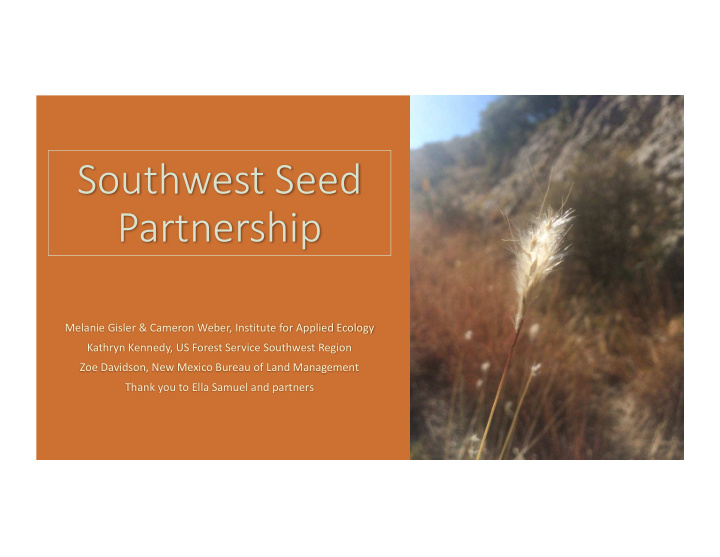



Southwest Seed Partnership Melanie Gisler & Cameron Weber, Institute for Applied Ecology Kathryn Kennedy, US Forest Service Southwest Region Zoe Davidson, New Mexico Bureau of Land Management Thank you to Ella Samuel and partners
I. Impetus for Seed Partnership Wildfire aftermath Bare ground -major issue for SW Too extensive for single organization to cover seed needs Crosses land ownership
Adios seed bank
• Locally adapted seed • High genetic diversity • Species diversity
Commercial sources of native seed in SW Granite Seed • Few producers Seed from outside region • Cultivars (lower genetic diversity) • Southwest Seeds Curtis and Curtis Bamert Seed Co.
II. History of Partnership Initiated October 2015 More seed & better seed & program 2012 Willamette Valley Native Plant Partnership, OR in 2012.
Willamette 15 years ago Valley OR Uncoordinated, duplicated efforts
Willamette Valley Plant Materials Partnership 30 partners Signed MOU Pool resources for coordination, collection, production 50 species in production Corvallis Plant Materials Center
Southwest Seed Partnership National and Regional Forest Service R3 Bureau of Land Management Institute for Applied Ecology National Park Service US Fish and Wildlife Service Natural Resources Conservation Service New Mexico Quivira Coalition NM Department of Transportation NM Land Conservancy Pueblo of Santa Ana NM Dept. of Energy Minerals and Natural Resources NM Game and Fish Arizona Verde Valley Native Plant Materials Partnership Borderlands Restoration
III. Primary Purpose of Partnership and What We Do Implement National Seed Strategy National Strategy Goals SW Seed Partnership Steps 1. Assessments and prioritization 2. Seed collection and tracking 3. Accessions based on science 4. Production 5. Collaboration and coordination Improve supply and diversity of native seed for NM and AZ
ASSESSMENTS Step 1 Determine Omernik, Level III Geographic Priorities Which ecoregions have the greatest demand for seed? AZ NM Plateau
Step 2 Identify Target Species Species in demand? Workhorse Widespread Desired attributes? Establish well/competitive Easy to collect & grow Early seral Wildlife and cultural uses Nitrogen fixing Pollinator plants
Step 3 Green and Blue = collections Collect Seed made for SWSP Diversity: geographic • within population • temporal • Past collections that can be utilized for production Ella Samuel
2016 Seed Crew 5 Partner Collaboration NM Forest Service R3 NM Bureau of Land Management National Park Service Institute for Applied Ecology AZ Verde Watershed Plant Materials Program 6 ecoregions, >200 populations from 62 species Cover 2 program needs: SOS and SWSP
Step 4 Track Seed Erickson, US Forest Service R6 Can we share databases with partners or make data cross walks?
BUILD ACCESSIONS BASED ON SCIENCE Step 5 Determine seed zones Balance genetic contributions
PRODUCTION Step 6 Production 2017 NM & AZ Contracting 4-10 small to medium-sized test fields Matrix grasses, pollinator resource plants, annual
COLLABORATION AND COORDINATION Steps 1-7 Check-in meetings w/core partners (4x/month) Stakeholder Meeting (1x/year) April 26, 2017, ABQ Committees Steering Grower Advisory Seed Quality Species Selection
IV. Critical assessment of what we are lacking Lack: SW producers. Experience and appropriate farm equipment for native species production.
Solution • Outreach - make case to farmers to convert other ag crops to native Native species require less water (water shortages in SW) • Listen to and respond to needs, offer training, and involve in R &D
Preliminary Approach Small-medium scale Test cultivation of new Curtis and Curtis Seed species, pollinator plots, nursery production Pu Pueblo of of Tesuque Pu Pueblo of of Santa Ana Large scale, established Familiar grasses and forbs
Lack: Not all land managers educated about merits of diversity and local seed “Know where your seed comes from” “Request seed tests” Solution Outreach to land managers Stronger policy language: NM DOT changed seed purchasing requirements to prioritize local, native seed
Lack: Seed Solution Transfer Zone Common Garden Data Seed Zone Mapper Tool Expert Feedback Provisional Seed Zones Genetic studies Life history traits
Lack: Foresight of future seed needs plus seed for emergency needs Collection 1-2 years Solution First harvest Plan 5 years ahead 1-4 years (Best yield 2-4 years) Seed available This image cannot currently be displayed. in 4-10 years Cultivation 2 + years for projects
Solution
Thank You
The preceding presentation was delivered at the 2017 National Native Seed Conference Washington, D.C. February 13-16, 2017 This and additional presentations available at http://nativeseed.info
Recommend
More recommend